The Plextor M6V (256GB) SSD Review
by Billy Tallis on October 12, 2015 8:00 AM ESTSequential Read Performance
Just like the random read test, sequential reads are tested across the span of a full drive and a representative sample of queue depths. Most operations involving large files (typically images and videos) fall under this test's purveiw, but streaming or playing even the highest resolution videos won't be a challenge for any of these drives. Copying files to another SSD or loading a new level in a video game would be more likely to show noticeable difference from better performance here.
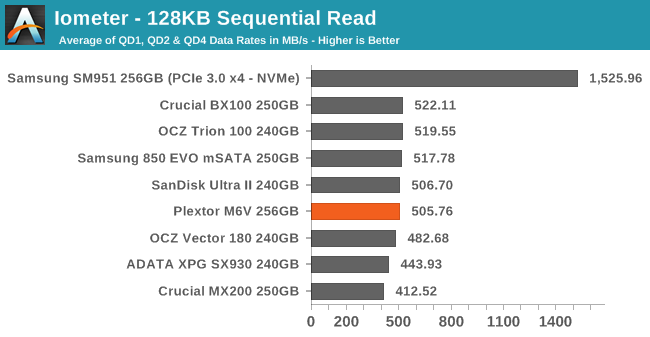
The SATA interface's speed limit determines almost everything in this graph. Almost all drives, including the M6V, are close enough that the differences hardly matter.
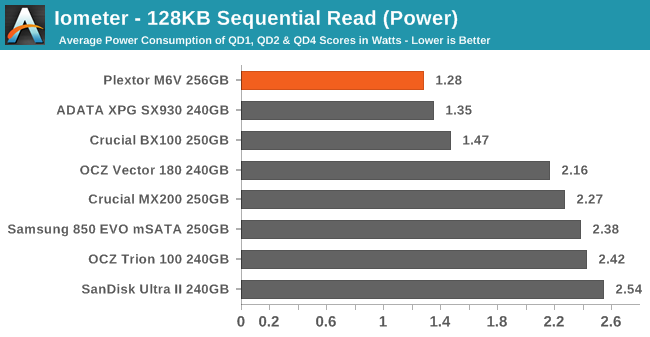
On the other hand, power consumption varies considerably. The TLC drives are at the bottom as usual, and the M6V is at the top with only a little bit of competition.
 |
|||||||||
| Default | |||||||||
The queue depth scaling reveals the source of the variation in the averages above. The only drives below the M6V in performance are the ones that can't hit the limit at a queue depth of two, and the drives above the M6V all have better QD 1 performance.
Sequential Write Performance
The sequential write isn't limited to a small span of the disk, as that usually doesn't make a difference for this performance metric. As always, our averages are of the lower queue depths, but scaling to higher queue depths is also investigated. Bulk file copies and recording uncompressed video are the kind of uses that depend on sequential write performance.
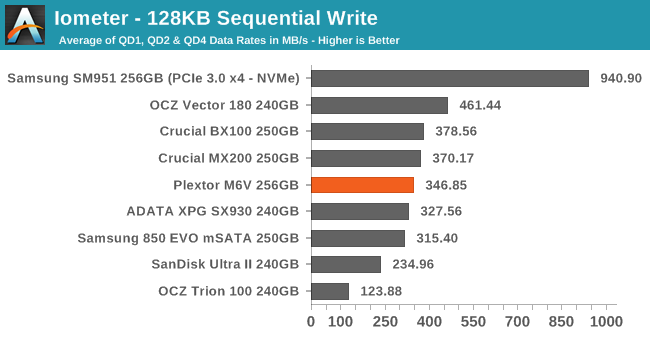
The M6V is back in the middle of the pack, and none of the SATA drives of this size are quite able to reach the limit of the interface.
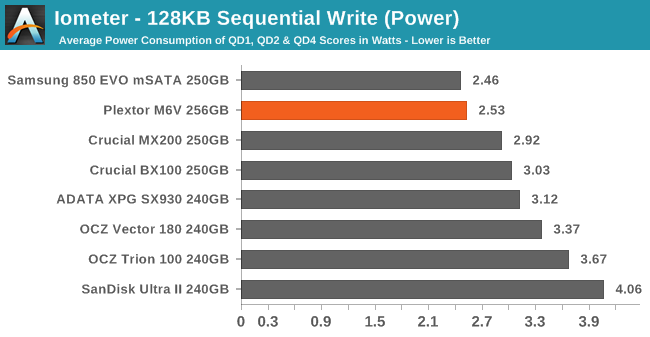
The M6V doesn't quite take first place for power consumption, but it comes within spitting distance of the surprisingly efficient Samsung 850 EVO.
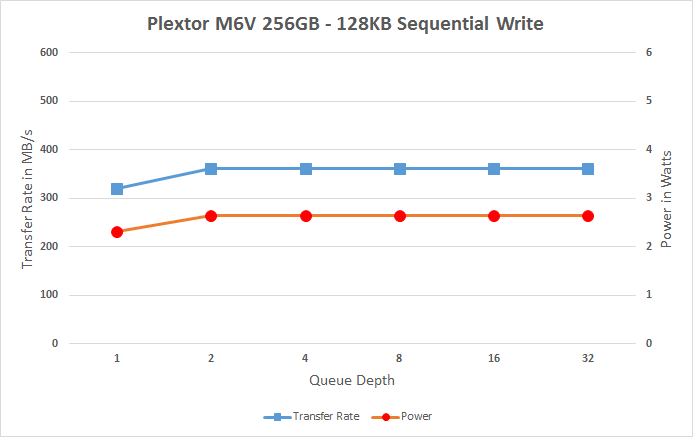 |
|||||||||
| Default | |||||||||
Most drives have flat performance across this test, indicating that a 128kB block of data is already large enough for the drive to extract all the speed it can.










51 Comments
View All Comments
mczak - Monday, October 12, 2015 - link
I beg to differ. For 90% of all use cases, the performance difference of a pcie drive to a sata one will be minimal if not unnoticeable whereas the pcie one is a lot more expensive (for now - I don't see a technical reason for this, really). Whereas everybody probably agrees the performance difference from sata ssd to sata HD is definitely noticeable.Albeit this drive indeed doesn't really offer anything interesting. There's nothing wrong with that but that means it has to nearly exclusively compete based on price, which it currently does not.
svan1971 - Monday, October 12, 2015 - link
simply not true, having used an sm951 for 3 months now the performance increase over the 850 is absolutely noticeable from bootup to shutdown and everything in between.geniekid - Monday, October 12, 2015 - link
http://techreport.com/review/28446/samsung-sm951-p...According to techreport boot times are noticeably faster and general loading times are not.
JimmiG - Tuesday, October 13, 2015 - link
We're still just talking about a few seconds difference. Most people won't notice the difference between a boot time of 37 seconds and 33 seconds. What people will notice is the difference between *any* SSD and any regular HDD.Most consumers should just get the cheapest SSD at the highest capacity they can afford. The performance difference isn't enough to justify going with e.g. a higher-performance 250GB SSD over a slightly slower 500GB drive (which allows you to store more of your data on the SSD instead of your much slower HDD).
mapesdhs - Wednesday, October 14, 2015 - link
Irony is, right now the 850 EVO is also one of the best value SSDs available. Atm I wouldn't choose anything else for mainstream use.emn13 - Tuesday, October 13, 2015 - link
Even if this were true (which really depends on your workload - for common workloads it really isn't), that doesn't mean it'd be a good idea to pick between the extremely expensive PCIe solutions and the extremely slow HDD solutions - old fashioned SATA still commands the sweet spot.Perhaps not for much longer, of course :-).
Clauzii - Monday, October 12, 2015 - link
Also, try hotswapping a PCIe-card :)Billy Tallis - Monday, October 12, 2015 - link
M.2 doesn't support hotplug, but it's been part of PCIe forever and is supported by both the normal full size expansion card form factor and the U.2 connector. The problem is that consumer-class systems often don't bother to fully implement support for the feature, though obviously they support it on some level for the sake of ExpressCard and Thunderbolt.Ramalth - Wednesday, October 14, 2015 - link
Not taking in consideration that you cannot add or replace (most) laptops HDD with PCI-Express versions, so you have to use a SATA drive forcefully ...devione - Monday, October 12, 2015 - link
What's the point of having bicycles when there are cars?What's the point of having cars when there are airplanes?